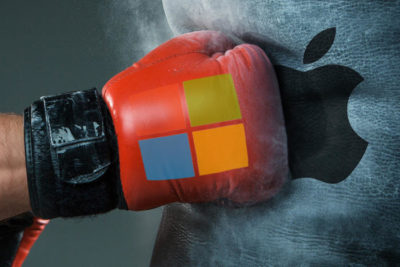As more consumers grow disenchanted with Apple, Microsoft has taken the opportunity to cash in on the growing popularity of Surface devices.
Microsoft claims that more people are switching to Surface devices from Macs than ever before. That’s a concept that would have been hard to picture when Microsoft first released the Microsoft Surface RT and Surface Pro in 2012 and 2013, respectively. The Surface RT suffered from a watered-down version of the new — and generally disliked — Windows 8 operating system and, while the Surface Pro featured the full desktop version, it came with hardware limitations and a high price tag.
In a sea of clam shell notebooks, all vying to be thinner and lighter than the last, the Surface clumsily debuted as a confusing mashup of a tablet and a laptop. And people didn’t like it. RT users complained of the limited functionality and never-ending bugs, while Surface Pro users were forced to pay a high price just to avoid Windows RT. In fact, the Surface RT did so poorly that Microsoft had to take a $900 million dollar write-down after drastically cutting the price of the device.
The backlash even made some question whether or not we were witnessing the end of Microsoft. It might seem dramatic now in 2016, but in 2013, people really missed the Start menu. Instead, Microsoft listened to consumers’ complaints to find a balance between the company’s vision and what consumers wanted. And it worked — Microsoft has regained credibility and popularity by creating new products that didn’t simply mimic or improve upon what was already out there.
Apple’s identity crisis
For a company once targeting modern, creative professionals, it’s hard to tell who Apple makes products for anymore. Apple’s devices now feel tailored to a low-tech crowd, or people who like new tech, but just aren’t that interested in specs. They want a reliable, easy-to-use device that just works. But where does that leave the original fan base of creative workers who need high-performance and cutting edge features? Apple hasn’t left this industry with many options — and at this point, you can get more for your money in graphics and performance on a Surface Book than a Macbook Pro. Plus, with the newly announced Microsoft Studio, there is finally a strong alternative to the iMac — with a touch display, no less.
Apple’s compromise is the MacBook Pro with Touch Bar, which features a dynamic touch bar replacing the row of function keys on the keyboard. The display changes depending on settings and the app you’re using; it’s a cool feature, and certainly useful, but it’s a confusing message. If the iPad Pro is competing with hybrid notebooks like the Surface Pro 4, but Apple doesn’t think people want touch-displays on a notebook, then does that make the iPad Pro a giant iPad?
Microsoft is focused on touch-based input — in fact, you’d be hard-pressed to find even a mid-ranged PC that doesn’t at least offer the option of an upgrade to a touch display. The two companies have taken different stances, but in siding with touch, Microsoft has more to offer in each of its devices. If you want a notebook that can sometimes be a tablet, or a tablet that can sometimes be a notebook, you can purchase just one device instead of two.
Microsoft has focused on developing a family of Surface devices that can suit a wide range of users. It starts with the lower-end Surface 3, which is a great device for anyone who just wants a computer to surf the web and use basic apps. The Surface Pro 4 acts as a step up in size and hardware, with configurations for anyone from light users to those who need more performance. And now, with the Surface Book and Surface Studio, even those who need the highest end configurations for heavy-duty video or image editing have an option.
The Surface in pop culture
Remember when Windows users were the boring, out of touch, suit-wearing nerds in commercials, and a Mac user was the hipster CEO of a startup — that guy in 2006 who wore hoodies and scootered to all his meetings? That landscape has changed a lot since then, and now Microsoft is the one calling out Apple on selling outdated hardware and falling behind the curve.
Microsoft has clearly made a push to get the Surface in front of consumers anyway possible — CNN commentators used the devices in this year’s debates, but it was later discovered they were using them to hide their iPads. Hulu’s The Mindy Project also features Mindy Kaling’s character using a Surface Book, with one very obvious instance of product marketing, where she very purposefully ejects the display from the keyboard. And what New Englander can forget when the Surface Pro 4 made headlines after Patriot’s coach, Bill Belichick, became so frustrated with the technology that he spiked it onto the field.
These might not be the most positive representations of the brand, but the visibility of the device seems to be working. In places where it used to be a sea of aluminum notebooks, featuring the familiar, backlit Apple logo, we’re starting to see some diversity.
Just as it wasn’t the end of Microsoft in 2013, it’s now Apple’s chance to step out of the spotlight and make some changes. But there’s nothing like a little healthy competition to help spark new, creative designs and that’s exactly what motivated Microsoft to step back, refocus and come back strong.
Have questions?
Get answers from Microsofts Cloud Solutions Partner!
Call us at: 856-745-9990 or visit: https://southjerseytechies.net/
South Jersey Techies, LL C is a full Managed Web and Technology Services Company providing IT Services, Website Design Services, Server Support, Network Consulting, Internet Phones, Cloud Solutions Provider and much more. Contact for More Information.
To read this article in its entirety click here.


